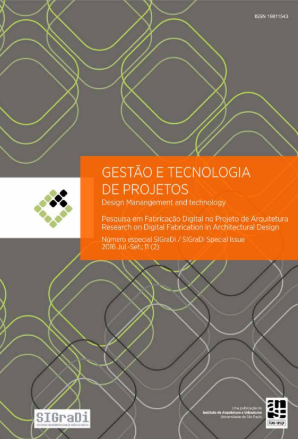FAB!t Pavilion: a portable proposal to include the maker culture in traditional education
DOI:
https://doi.org/10.11606/gtp.v14i1.148143Keywords:
Maker culture, Digital fabrication, Parametric design, Temporary architecture, Maker educationAbstract
Fab!t Pavilion is a portable pavilion to foster the inclusion of the maker culture in traditional education, introducing in the elementary school’s programs the concept of industry 4.0, approaching the shift in the productive systems, especially regarding the manufacture and its implication on the new relationship consumer-product. In this scenario, the so-called maker culture intends to disseminate these technological advances and democratizing its access in traditional education. This work intends to update the teaching of technology in schools by introducing the fundaments of the maker culture, it in a fast, cheap and egalitarian way. As methodology, we studied and analysed several existing laboratories known as Fab Labs to identify their activities and the tools used in their spaces. Based on the study we developed a modular system to enable customized spaces that comply with the equipment’s functional requirement and related activities. For that, we propose a mountable and demountable construction platform and a system to enable the expansion and retraction of the structure, to adapt for future reuse of the community.
Downloads
References
BLIKSTEIN, P. Digital Fabrication and ’Making’ in Education: The Democratization of Invention. In
J. Walter-Herrmann & C. Büching (Eds.), FabLabs: Of Machines, Makers and Inventors. Bielefeld: Transcript Publishers, 2013.
BUITONI, C.S. Mayumi Watanabe Souza Lima: a construção do espaço para a educação. FAU USP: São Paulo, 2009.
DÍEZ, T. Personal Fabrication: Fab Labs as Platforms for Citizen-Based Innovation, from Microcontrollers to Cities. Digital Fabrication: 457-68. Nexus Network Journal. Vol.14, No. 3, 2012.
DUNN, N. Digital Fabrication in Architecture. Laurance King Publishing: Londres, 2012
EYCHENNE, F. e NEVES, H. Fab Lab: A Vanguarda da Nova Revolução Industrial. São Paulo: Editorial Fab Lab Brasil, 2013.
FAB 12 - The 12th Fab Lab Conference and Symposium. Disponível em: , 2016.
FAB LAB SEOUL. Fab Pavilion. Disponível em: <https://www.fablabs.io/ projects/136>, 2016.
FAB FOUNDATION. How to Start a Fab Lab: The Space. Disponível em: , 2016.
FAB FOUNDATION. Labs Map. Disponível em: <https://www.fablabs.io>, 2016.
FAB FOUNDATION. What is a Fab Lab? Disponível em: , 2016.
GERSHENFELD, N. Fab: The Coming Revolution on Your Desktop – From Personal Computers to Personal Fabrication. New York: Basic Books, 2005.
GERSHENFELD, N. How to Make Almost Anything: The Digital Fabrication Revolution. Cambridge: Foreign Affairs (91), 2012, pp. 43-57.
INSTITUTO NACIONAL DE ESTUDOS E PESQUISAS EDUCACIONAIS ANÍSIO TEIXEIRA - INTP (INEP). Censo Escolar 2016. Brasília: MEC, 2017.
IOWA STATE UNIVERSITY. two Xtwo (2016). Disponível em: <http://new.arch. iastate.edu/tag/twoxtwo/>, 2016.
ITSBRASIL. Conheça o Fab Lab Livre SP. Disponível em: <http://fablab.itsbrasil.org.br/o-que-e>, 2016.
IWAMOTO, L. Digital Fabrications: Architectural and Material Techniques. Princeton Architectural Press: Nova Iorque, 2009.
KOLAVERIC, B. Designing and Manufacturing Architecture in the Digital Age. Architectural Information Management – 05 Design Process 3. 2003.
MAKERSPACES. MakedED Resources for School Makerspaces 2nd Edition. Disponível em: , 2016.
MAKERSPACES. Resources For Starting and Running a Mobile Makerspace. Disponível em: , 2016.
MENDONÇA, D.; PÁSSARO, A.; HENRIQUES, G. C. Ferramenta Generativa para Wiki House. Trabalho de Conclusão de Curso (Graduação em Arquitetura e Urbanismo) - FAU UFRJ: Rio de Janeiro, 2016.
PASSARO, A.; ROHDE, C. Casa Revista: arquitetura de fonte aberta. Gestão e Tecnologia de Projetos: São Carlos, v. 11, n. 2, p. 25-41 jul-set, 2016.
REZENDE, F. As Novas Tecnologias na Prática Pedagógica Sob a Perspectiva Construtivista. ENSAIO – Pesquisa em Educação em Ciências (Belo Horizonte), Belo Horizonte: v. 2, n. 1, 2000, p. 70-87.
REMY, T.; VEENHUIZEN, R. Clubhouse (2009). Disponível em: <http://www.remyveenhuizen.nl/work/public-space/clubhouse>, 2016.
SPERLING, D. M.; HERRERA, P. C. Homo faber: digital fabrication in Latin America. CAAD futures 2015> the next city. 1. ed. São Carlos: Instituto de Arquitetura e Urbanismo, 2015.
The Maker Map. Disponível em: <http://themakermap.com>, 2016.
Downloads
Published
Issue
Section
License
Copyright Notice
Authors who publish in this journal agree to the following terms:
- Authors retain the copyright and grant the journal the right of first publication, with the article simultaneously licensed under the Creative Commons Attribution License BY NC ND, which allows the sharing of article with acknowledgment of authorship and initial publication in this journal.
- Authors are authorized to take additional contracts separately, for non-exclusive distribution of version of the article published in this journal (e.g. publish in institutional repository or as a book chapter), with acknowledgment of authorship and initial publication in this journal.
- Authors are allowed and encouraged to publish and distribute their research work online (e.g. in institutional repositories or on their personal page) at any point before or during the editorial process, as this can generate productive changes, as well as increase the impact and the citation of published article (See O Efeito do Acesso Livre).



